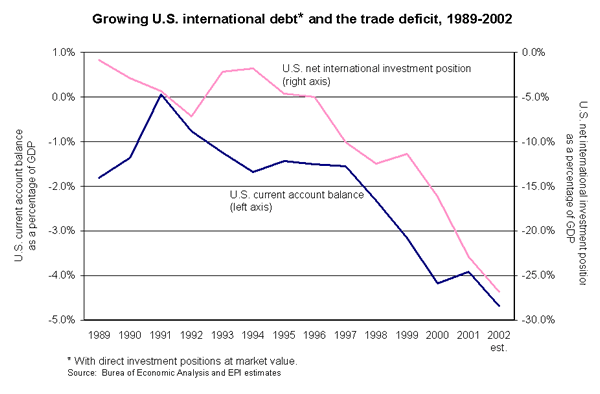Snapshot for January 15, 2003.
U.S.’s growing trade deficit fuels ballooning net foreign debt
The U.S. is headed for a record trade deficit of nearly $500 billion in 2002, or 4.7% of U.S. GDP.* These figures are based on the current account balance, the broadest measure of U.S. trade flows including all services and transfer payments. Current account deficits are financed through inflows of foreign capital that result in growing levels of foreign debt.

Accordingly, U.S. net foreign debt (equivalent to net international investment in the U.S.) is expected to reach an all-time high of $2.8 trillion in 2002, or nearly 27% of total U.S. GDP, as shown by the purple line in the figure above. Note that the U.S. net international investment position is negative throughout this period, meaning that the U.S. is, on balance, in debt to the rest of the world. The foreign debt soared in the 1990s, because of massive current account deficits. The rapid growth of U.S foreign debt threatens the stability of the U.S. economy: if foreign investors grow wary about the U.S. inability to borrow enough to finance this debt, it could result in a financial panic that would lead to soaring interest rates, a collapse in the dollar and a deep recession or depression. The U.S. is not immune to the financial laws of gravity. We too are vulnerable to the types of crises that have swept through Argentina and many other developing countries in recent years. Even the International Monetary Fund has recognized this potential for instability, albeit in its own arcane language, when it reported that current account imbalances “have risen to levels almost never seen in industrial countries, [and these] global imbalances [could result] in an abrupt and disruptive adjustment of major exchange rates.” In other words, there is great risk that a major financial panic will hit the United State and world economy, unless the growth of trade deficits is reversed.
*This refers to the current account deficit. Although official figures on the current account for the full year will not be available until March, EPI estimates, based on current trends, that the current account will reach $ – 489 billion for all of 2002.
This week’s Snapshot by EPI economist Robert E. Scott.
Check out the archive for past Economic Snapshots.
Preferred Citation: Economic Policy Institute, “Economic Snapshots, [insert date].” Washington, D.C.: Economic Policy Institute, 2003.
